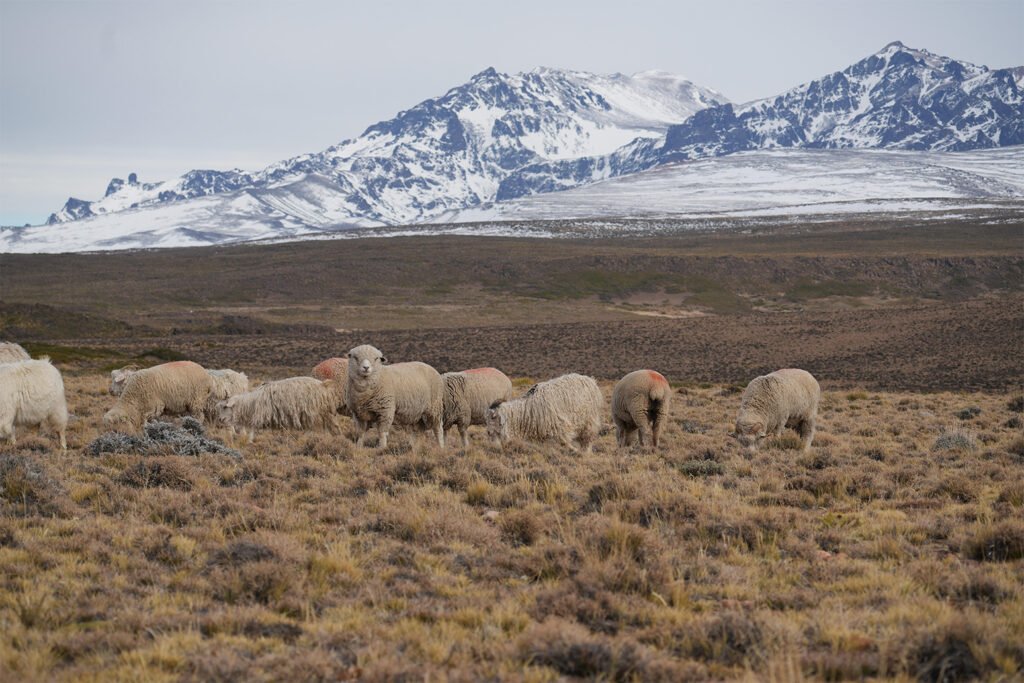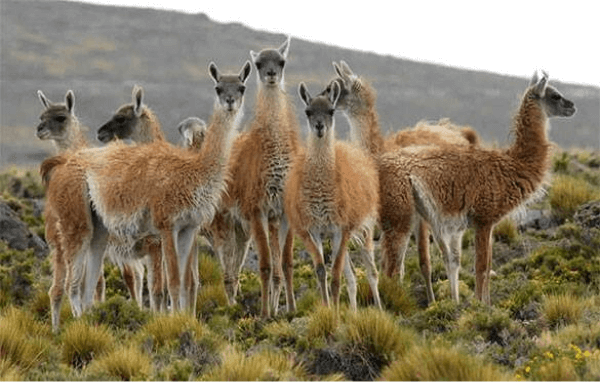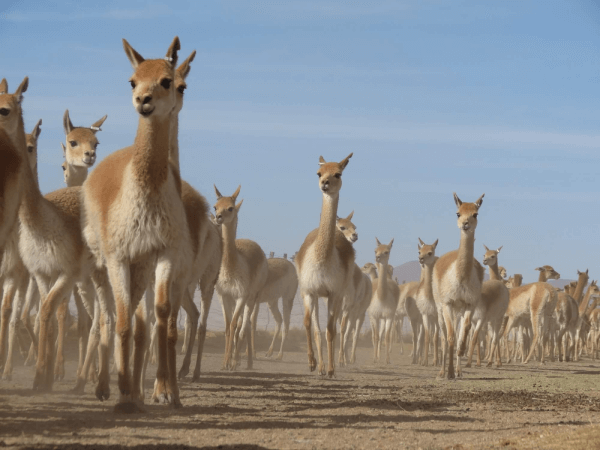ANIMAL NATURAL FIBERS
Merino Península Valdés certified Wildlife Friendly
Merino wool is a natural fiber produced by Merino sheep; it’s thinner and softer than regular wool, and offers many benefits thanks to its outstanding characteristics. Regenerative and Wildlife Friendly® certified producers of Merino are based in contrasting and spectacular landscapes throughout Patagonia, Argentina. Accompanied by Wildlife Conservation Society (WCS), they make significant efforts to bring the power of regenerative grazing and Wildlife Friendly practices to enable climate resilience and co-existence between wildlife and sheep wool production in the region.
Merino wool is very popular for its warmth, lightweight and softness
MICRONS
Its very thin diameter ranges from 17 to 24 microns
USES
From high art couture pieces to rugged outdoor garments, Merino wool adapts to several uses.
SEASONS
Shearing: October/November
Stockpiling: November
Available from November
WFEN certified producers of Merino in Patagonia make big efforts to keep the sheep farming business and traditions alive in the area, reconverting their practices towards sustainable and regenerative livestock farming. They manage their land to allow healthy populations of guanacos, rheas, and maras to co-exist with their sheep. Also, they use non-lethal methods – such as livestock guarding dogs and deterrent lights – to control predation by pumas, foxes, and other wild carnivores, and manage grazing to favor regeneration of grass lands and soils, helping to mitigate the impacts of climate change.
World Heritage Site Península Valdés, Chubut Certified ranches at the area total 33 000 ha. of land under a Regenerative and Wildlife Friendly management scheme and produce around 50 tons per year of fine Merino wool in harmony with populations of guanacos, rheas, and maras. As the properties comprise over 70 km of coastline, the group stewards some of the most important sea lion and elephant seal colonies in the area, as well as marine and migrator y birds and the presence of hundreds of southern right whales.
Regeneration and coexistence with wildlife
The 270,000-square-mile Patagonian Steppe is the last stronghold of the guanaco, including the world’s largest migrator y population of the species, and is home to the southernmost population of the endangered Andean cat, Darwin’s rhea, Andean condor, many endemic species of plants and lizards, tens of thousands of swans and flamingos, and native predators like pumas and foxes. Although seemingly wild and timeless, human activities have greatly altered the biodiversity of Argentina’s steppes. The Certified Regenerative and Wildlife Friendly Merino wool production is centred on both regenerative grazing and on the coexistence between sheep ranching and healthy wildlife populations.

Merino Península Valdés certified Wildlife Friendly
Merino wool is a natural fiber produced by Merino sheep; it’s thinner and softer than regular wool, and offers many benefits thanks to its outstanding characteristics. Regenerative and Wildlife Friendly® certified producers of Merino are based in contrasting and spectacular landscapes throughout Patagonia, Argentina. Accompanied by Wildlife Conservation Society (WCS), they make significant efforts to bring the power of regenerative grazing and Wildlife Friendly practices to enable climate resilience and co-existence between wildlife and sheep wool production in the region.
Merino wool is very popular for its warmth, lightweight and softness
MICRONS
Its very thin diameter ranges from 17 to 24 microns
USES
From high art couture pieces to rugged outdoor garments, Merino wool adapts to several uses.
SEASONS
Shearing: October/November
Stockpiling: November
Available from November
WFEN certified producers of Merino in Patagonia make big efforts to keep the sheep farming business and traditions alive in the area, reconverting their practices towards sustainable and regenerative livestock farming. They manage their land to allow healthy populations of guanacos, rheas, and maras to co-exist with their sheep. Also, they use non-lethal methods – such as livestock guarding dogs and deterrent lights – to control predation by pumas, foxes, and other wild carnivores, and manage grazing to favor regeneration of grass lands and soils, helping to mitigate the impacts of climate change.
World Heritage Site Península Valdés, Chubut Certified ranches at the area total 33 000 ha. of land under a Regenerative and Wildlife Friendly management scheme and produce around 50 tons per year of fine Merino wool in harmony with populations of guanacos, rheas, and maras. As the properties comprise over 70 km of coastline, the group stewards some of the most important sea lion and elephant seal colonies in the area, as well as marine and migrator y birds and the presence of hundreds of southern right whales.
Regeneration and coexistence with wildlife
The 270,000-square-mile Patagonian Steppe is the last stronghold of the guanaco, including the world’s largest migrator y population of the species, and is home to the southernmost population of the endangered Andean cat, Darwin’s rhea, Andean condor, many endemic species of plants and lizards, tens of thousands of swans and flamingos, and native predators like pumas and foxes. Although seemingly wild and timeless, human activities have greatly altered the biodiversity of Argentina’s steppes. The Certified Regenerative and Wildlife Friendly Merino wool production is centred on both regenerative grazing and on the coexistence between sheep ranching and healthy wildlife populations.


Guanaco
The Guanaco fiber is part of the so-called special fibers, originating from the camelids (Llama, Alpaca, Vicuña and Guanaco). Guanaco used in MAYDI’s designs comes from a cooperative in Payunia, Mendoza that has sustainable management of the specie.
The whole extraction process is done by hand. Ancestral techniques are used thanks to the processing with distaff. It is one of the finest fibers in the world, known for its silkiness, lightness and for its insulating property. The Guanaco is a “rare” fiber, special, that is why it is meant for the confection of high-quality pieces and clothing.
Guanaco
The Guanaco fiber is part of the so-called special fibers, originating from the camelids (Llama, Alpaca, Vicuña and Guanaco). Guanaco used in MAYDI’s designs comes from a cooperative in Payunia, Mendoza that has sustainable management of the specie.
The whole extraction process is done by hand. Ancestral techniques are used thanks to the processing with distaff. It is one of the finest fibers in the world, known for its silkiness, lightness and for its insulating property. The Guanaco is a “rare” fiber, special, that is why it is meant for the confection of high-quality pieces and clothing.

Llama
A natural and wild fiber. It is part of the family of the camelids. MAYDI´s Llama comes from La Puna, Jujuy. Its wool gets extracted thanks to a shearing process, respecting fully the animal and without harming him.
The entire process takes about 8 months in total, including the shearing, the careful selection by color and quality, the washing, the drying, then the spinning machine is used.
The Llamas are native from South America and grow up freely in Argentina. These animals are used to live in high, cold, and dry areas. The Argentine Llama is of excellent quality, regarding its brightness, silkiness, and fineness.

Llama
A natural and wild fiber. It is part of the family of the camelids. MAYDI´s Llama comes from La Puna, Jujuy. Its wool gets extracted thanks to a shearing process, respecting fully the animal and without harming him.
The entire process takes about 8 months in total, including the shearing, the careful selection by color and quality, the washing, the drying, then the spinning machine is used.
The Llamas are native from South America and grow up freely in Argentina. These animals are used to live in high, cold, and dry areas. The Argentine Llama is of excellent quality, regarding its brightness, silkiness, and fineness.


Baby Llama
A natural and young fiber, originating from the first shearing of the Baby Llama. It is part of the family of the camelids. Its wool gets extracted thanks to a shearing process, respecting fully the animal and without harming it.
The Baby Llama has an exclusive quality of fiber, coming from the first shearing of the animal, and for this reason, it is more soft and more costly, by being more special and exclusive.
Baby Llama
A natural and young fiber, originating from the first shearing of the Baby Llama. It is part of the family of the camelids. Its wool gets extracted thanks to a shearing process, respecting fully the animal and without harming it.
The Baby Llama has an exclusive quality of fiber, coming from the first shearing of the animal, and for this reason, it is more soft and more costly, by being more special and exclusive.

Mohair certified Wildlife Friendly
Mohair is the fleece of the Angora goat and is one of the world’s most beautiful natural fibers; it stands out for its white, silky and shiny fiber. Due to its rapid growth in length, two annual harvests can be obtained to meet the current demands of the textile industry. Regenerative and Wildlife Friendly® certified producers of mohair are based in contrasting and spectacular landscapes in northern Patagonia, Argentina. Accompanied by the Wildlife Conservation Society (WCS), they make significant efforts to bring the power of regenerative grazing and Wildlife Friendly practices to enable climate resilience and co-existence between wildlife and goat fiber production.
This beautiful and noble natural fiber is lustrous, versatile and offers an exceptional colour reflection. Mohair has become a symbol of luxury and exclusivity.
Autumn (Southern Hemisphere)
- Shearing: from March 15th to April 15th.
- Stockpiling: from April 15th to May 15th.
- Available from May 15th.
- Average amount: 7.000 kg of raw mohair.
Spring (Southern Hemisphere)
- Shearing: from September 15th to October 15th.
- Stockpiling:from October 15th to November 15th.
- Available from November 15th.
- Average amount: 20.000 kg of raw mohair.
North-central Neuquén, in northern Patagonia, is the home of the producers who dedicate their lives to breed Angora goats and constantly improve the quality of this wonderful fiber.
The producers are mostly small scale but they have shown that when they unite (as in the Cooperativa Agropecuaria de Pequeños Productores de la zona Centro) they get much better results, in terms of fiber quality, logistics, and of course, profits and sustainability. More than 20,000 kilograms of mohair are produced annually by the Cooperativa. Working together with WCS Argentina, they are finding ways to regenerate grass lands and soils and coexist with wildlife, using methods to avoid predation without killing native carnivores.
More than 50.000 ha. protected by regenerative and wildlife friendly management
In Neuquén province, more than 50.000 hectares are being protected through Regenerative and Wildlife Friendly management methodologies adopted by herders, such as using livestock guarding dogs and deterrent lights. The area includes Laguna Blanca National Park, home to large numbers of birds, such as flamingos and black-necked swans, and the critically endangered Patagonian frog, a local endemic species.
The certified Regenerative and Wildlife Friendly Mohair fiber production is based on the integration between practices of regenerative grazing and coexistence between goat husbandry and healthy wildlife populations. Vast Patagonian steppe and scrub habitats and soils, and endangered species like the Andean cat and Andean condor or key species like puma, guanaco, lesser rhea and culpeo fox are restored and protected by certified producers, WCS and WFEN promote smaller, healthier, and more productive herds and the use of non-lethal methods to minimize predation, restore ranges and soils, and conserve functional carnivore populations.

Mohair certified Wildlife Friendly
Mohair is the fleece of the Angora goat and is one of the world’s most beautiful natural fibers; it stands out for its white, silky and shiny fiber. Due to its rapid growth in length, two annual harvests can be obtained to meet the current demands of the textile industry. Regenerative and Wildlife Friendly® certified producers of mohair are based in contrasting and spectacular landscapes in northern Patagonia, Argentina. Accompanied by the Wildlife Conservation Society (WCS), they make significant efforts to bring the power of regenerative grazing and Wildlife Friendly practices to enable climate resilience and co-existence between wildlife and goat fiber production.
This beautiful and noble natural fiber is lustrous, versatile and offers an exceptional colour reflection. Mohair has become a symbol of luxury and exclusivity.
Autumn (Southern Hemisphere)
- Shearing: from March 15th to April 15th.
- Stockpiling: from April 15th to May 15th.
- Available from May 15th.
- Average amount: 7.000 kg of raw mohair.
Spring (Southern Hemisphere)
- Shearing: from September 15th to October 15th.
- Stockpiling:from October 15th to November 15th.
- Available from November 15th.
- Average amount: 20.000 kg of raw mohair.
North-central Neuquén, in northern Patagonia, is the home of the producers who dedicate their lives to breed Angora goats and constantly improve the quality of this wonderful fiber.
The producers are mostly small scale but they have shown that when they unite (as in the Cooperativa Agropecuaria de Pequeños Productores de la zona Centro) they get much better results, in terms of fiber quality, logistics, and of course, profits and sustainability. More than 20,000 kilograms of mohair are produced annually by the Cooperativa. Working together with WCS Argentina, they are finding ways to regenerate grass lands and soils and coexist with wildlife, using methods to avoid predation without killing native carnivores.
More than 50.000 ha. protected by regenerative and wildlife friendly management
In Neuquén province, more than 50.000 hectares are being protected through Regenerative and Wildlife Friendly management methodologies adopted by herders, such as using livestock guarding dogs and deterrent lights. The area includes Laguna Blanca National Park, home to large numbers of birds, such as flamingos and black-necked swans, and the critically endangered Patagonian frog, a local endemic species.
The certified Regenerative and Wildlife Friendly Mohair fiber production is based on the integration between practices of regenerative grazing and coexistence between goat husbandry and healthy wildlife populations. Vast Patagonian steppe and scrub habitats and soils, and endangered species like the Andean cat and Andean condor or key species like puma, guanaco, lesser rhea and culpeo fox are restored and protected by certified producers, WCS and WFEN promote smaller, healthier, and more productive herds and the use of non-lethal methods to minimize predation, restore ranges and soils, and conserve functional carnivore populations.


Vicuña
The Vicuña forms part of the family of the camelids. It is a wild animal, like the Guanaco. Considered by the aboriginal peoples as the silk of the earth. Comes from El Condor, La Puna, Jujuy.
The extraction of the fiber happens through a shearing process, for which a special ceremony is organized, the ceremony of the Chaccu. The Vicuña fiber is considered between one of the finest and most sophisticated fibers of the world. Depending on its geographical location, the color can be rather lighter or darker.
This fiber has antiallergic properties, with an insulating power and comes out for its extreme softness. The process is entirely done by hand, from the spinning to the elaboration of the pieces using ancestral techniques
Vicuña
The Vicuña forms part of the family of the camelids. It is a wild animal, like the Guanaco. Considered by the aboriginal peoples as the silk of the earth. Comes from El Condor, La Puna, Jujuy.
The extraction of the fiber happens through a shearing process, for which a special ceremony is organized, the ceremony of the Chaccu. The Vicuña fiber is considered between one of the finest and most sophisticated fibers of the world. Depending on its geographical location, the color can be rather lighter or darker.
This fiber has antiallergic properties, with an insulating power and comes out for its extreme softness. The process is entirely done by hand, from the spinning to the elaboration of the pieces using ancestral techniques

Baby Alpaca
The term “Baby Alpaca” refers to the grading of the fineness of the fiber. It’s the softest part of an adult Alpaca (usually the chest), not the age of the animal. Alpaca fleece is soft and silky. It is lighter in weight and up to 7x warmer than sheep’s wool but very breathable because it has no lanolin, it is hypoallergenic, naturally water repellent and flame-resistant. Another bonus is that alpaca has a low environmental impact compared to other natural fibers. Alpacas are neat and clean. Incas valued alpaca wool more than silver and gold. Only royalty could wear it.

Baby Alpaca
The term “Baby Alpaca” refers to the grading of the fineness of the fiber. It’s the softest part of an adult Alpaca (usually the chest), not the age of the animal. Alpaca fleece is soft and silky. It is lighter in weight and up to 7x warmer than sheep’s wool but very breathable because it has no lanolin, it is hypoallergenic, naturally water repellent and flame-resistant. Another bonus is that alpaca has a low environmental impact compared to other natural fibers. Alpacas are neat and clean. Incas valued alpaca wool more than silver and gold. Only royalty could wear it.


